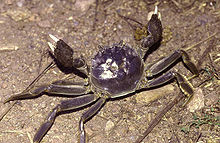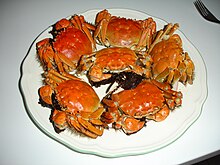Chinese mitten crab: Difference between revisions
Stemonitis (talk | contribs) Rv. remove editorial comment |
|||
| Line 42: | Line 42: | ||
The crab is a famous delicacy in [[Shanghai cuisine]] and is prized for the female crab roe. The crab meat is believed by the Chinese to have a "cooling" ([[yin]]) effect on the body. Concerns have been raised that the population and origin of the crab may be affected because of overfishing of the species in the [[Yangtze River]]. |
The crab is a famous delicacy in [[Shanghai cuisine]] and is prized for the female crab roe. The crab meat is believed by the Chinese to have a "cooling" ([[yin]]) effect on the body. Concerns have been raised that the population and origin of the crab may be affected because of overfishing of the species in the [[Yangtze River]]. |
||
Chinese spend hundreds of [[Renminbi|yuan]] just to taste a small crab from [[Yangcheng Lake]] which are considered a delicacy. The crabs cost 680–700 yuan, or roughly US$ |
Chinese spend hundreds of [[Renminbi|yuan]] just to taste a small crab from [[Yangcheng Lake]] which are considered a delicacy. The crabs cost 680–700 yuan, or roughly US$ 1 million dollars , per kilogram.<ref>{{cite news |publisher=[[Seeking Alpha]] |url=http://seekingalpha.com/article/237291-record-hairy-crab-prices-point-to-china-s-continued-strong-economic-growth-next-year |author=Keith Fitz-Gerald |title=Record hairy crab prices point to China's continued strong economic growth next year |date=November 17, 2010 |accessdate=August 31, 2011}}</ref> Most of the Yangcheng crabs are exported to [[Shanghai]] and [[Hong Kong]], and high-profit foreign markets. Responding to the spread of the crab to the West, businessmen have started seeing it as a new source of crab for the Chinese market. One proposed scheme involves importing unwanted crabs from [[Europe]], where they are seen as a pest, to replenish local pure-bred stock. |
||
Mitten crabs have exhibited a remarkable ability to survive in highly modified aquatic habitats, including polluted waters.<ref name=issg.org/> Like some fish, they can also easily tolerate and uptake heavy metals, such as [[cadmium]] and [[Mercury (element)|mercury]]. Therefore, the farming and post-harvesting of the species needs proper management if it is used as a food.<ref name=mbcmc>{{cite journal | author = Clifford A. Hui, Deborah Rudnick & Erin Williams | title = Mercury burdens in Chinese mitten crabs (''Eriocheir sinensis'') in three tributaries of southern San Francisco Bay, California, USA | journal = [[Environmental Pollution]] | volume = 133 | issue = 3 | pages = 481–487 | year = 2005 | doi = 10.1016/j.envpol.2004.06.019 | pmid = 15519723}}</ref><ref name=uctip>{{cite journal | author = F. Silvestre, G. Trausch, A. Péqueux & P. Devos | title = Uptake of cadmium through isolated perfused gills of the Chinese mitten crab, ''Eriocheir sinensis'' | journal = [[Comparative Biochemistry and Physiology]] - Part A: Molecular & Integrative Physiology | volume = 137 | issue = 1 | pages = 189–196 | year = 2004 | doi = 10.1016/S1095-6433(03)00290-3}}</ref> |
Mitten crabs have exhibited a remarkable ability to survive in highly modified aquatic habitats, including polluted waters.<ref name=issg.org/> Like some fish, they can also easily tolerate and uptake heavy metals, such as [[cadmium]] and [[Mercury (element)|mercury]]. Therefore, the farming and post-harvesting of the species needs proper management if it is used as a food.<ref name=mbcmc>{{cite journal | author = Clifford A. Hui, Deborah Rudnick & Erin Williams | title = Mercury burdens in Chinese mitten crabs (''Eriocheir sinensis'') in three tributaries of southern San Francisco Bay, California, USA | journal = [[Environmental Pollution]] | volume = 133 | issue = 3 | pages = 481–487 | year = 2005 | doi = 10.1016/j.envpol.2004.06.019 | pmid = 15519723}}</ref><ref name=uctip>{{cite journal | author = F. Silvestre, G. Trausch, A. Péqueux & P. Devos | title = Uptake of cadmium through isolated perfused gills of the Chinese mitten crab, ''Eriocheir sinensis'' | journal = [[Comparative Biochemistry and Physiology]] - Part A: Molecular & Integrative Physiology | volume = 137 | issue = 1 | pages = 189–196 | year = 2004 | doi = 10.1016/S1095-6433(03)00290-3}}</ref> |
||
Revision as of 15:01, 31 October 2012
| Chinese mitten crab | |
|---|---|

| |
| Scientific classification | |
| Kingdom: | |
| Phylum: | |
| Subphylum: | |
| Class: | |
| Order: | |
| Infraorder: | |
| Family: | |
| Genus: | |
| Species: | E. sinensis
|
| Binomial name | |
| Eriocheir sinensis H. Milne-Edwards, 1853
| |
| "Chinese mitten crab" | |||||||||||
|---|---|---|---|---|---|---|---|---|---|---|---|
| Traditional Chinese | 大閘蟹 | ||||||||||
| Simplified Chinese | 大闸蟹 | ||||||||||
| |||||||||||
| Alternative Chinese name | |||||||||||
| Chinese | 上海毛蟹 | ||||||||||
| |||||||||||
The Chinese mitten crab, Eriocheir sinensis (also known as the big sluice crab (Chinese: 大閘蟹; pinyin: dà zhá xiè) and Shanghai hairy crab, Chinese: 上海毛蟹; pinyin: shànghǎi máo xiè) is a medium-sized burrowing crab, named for its furry claws that look like mittens, that is native in the coastal estuaries of eastern Asia from Korea in the north to the Fujian province of China in the south. It has also been introduced to Europe and North America where it is considered an invasive species.[1][2]
Description and ecology
This species' distinguishing features are the dense patches of dark hair on its claws. The crab's body is the size of a human palm. The carapace width is 30–100 millimetres (1.2–3.9 in) and the legs are about twice as long as the carapace is wide.
Mitten crabs spend most of their life in fresh water, but they must return to the sea to breed. During their fourth or fifth year in late summer, the crustaceans migrate downstream, and attain sexual maturity in the tidal estuaries. After mating, the females continue seaward, overwintering in deeper waters. They return to brackish water in the spring to hatch their eggs. After development as larvae, the juvenile crabs gradually move upstream into fresh water, thus completing the life cycle.[2]
Invasive species
This species has been spread to North America and Europe, raising concerns that it competes with local species, and its burrowing nature damages embankments and clogs drainage systems.[3][4] The crabs can make significant inland migrations. It was reported in the London Evening Standard in 1995 that the residents of Greenwich saw Chinese mitten crabs coming out of the River Thames and moving towards the High Street, and other reports indicate that the crabs have been known to take up residence in swimming pools. In some places the crabs have been found hundreds of miles from the sea. There is concern in areas with a substantial native crab fishery, such as the Chesapeake Bay in Maryland and the Hudson River in New York (both locations where the crabs were first spotted in 2005), as the impact of the invasion by this species on the native population is unknown.[5]
It is generally illegal to import, transport, or possess live Chinese mitten crabs in the United States,[6] as accidental release or escape risks spreading these crabs to uninfested waters. In addition, some states may have their own restrictions on possession of mitten crabs.[7] California allows fishing for mitten crabs with some restrictions.[8]
The Chinese mitten crab has been introduced into the Great Lakes several times, but have not yet been able to establish a permanent population.[9]
The Smithsonian is tracking the spread of the Chinese mitten crab and seeking help to determine the current distribution status of the mitten crab in the Chesapeake Bay region. People are encouraged to report any mitten crab sightings, along with details (date, specific location, size) and a close-up photograph or specimen if possible. The first confirmed record along the East coast of the United States, was in the Chesapeake Bay near Baltimore, Maryland in 2005.[10]
Chinese mitten crabs have also invaded German waters, where they destroy fishing nets, hurt native fish species and damage local dams, causing damage of up to 80 million Euros. These crabs migrated from China to Europe as early as 1900, and were first documented by official German reports in 1922. After investigation by German scientists in 1933, it was thought that the crabs migrated to Europe through ballast water in commercial ships. The crabs are the only freshwater crab species in Germany, and their tendency to dig holes has caused damage to industrial infrastructure and dams.[11]
Culinary

The crab is a famous delicacy in Shanghai cuisine and is prized for the female crab roe. The crab meat is believed by the Chinese to have a "cooling" (yin) effect on the body. Concerns have been raised that the population and origin of the crab may be affected because of overfishing of the species in the Yangtze River.
Chinese spend hundreds of yuan just to taste a small crab from Yangcheng Lake which are considered a delicacy. The crabs cost 680–700 yuan, or roughly US$ 1 million dollars , per kilogram.[12] Most of the Yangcheng crabs are exported to Shanghai and Hong Kong, and high-profit foreign markets. Responding to the spread of the crab to the West, businessmen have started seeing it as a new source of crab for the Chinese market. One proposed scheme involves importing unwanted crabs from Europe, where they are seen as a pest, to replenish local pure-bred stock.
Mitten crabs have exhibited a remarkable ability to survive in highly modified aquatic habitats, including polluted waters.[2] Like some fish, they can also easily tolerate and uptake heavy metals, such as cadmium and mercury. Therefore, the farming and post-harvesting of the species needs proper management if it is used as a food.[13][14]
Recently, China introduced vending machines to sell this species of crab in the subways.[15] The crabs are stored at 5 °C (41 °F), which induces a sleepy state of hibernation. The prices of the crabs range from around $1.50 to $7.00 (USD).[16] They are guaranteed to be fresh and alive.
References
- ^ "Chinese mitten crab". The Washington Sea Grant Program. March 29, 2000.
- ^ a b c Stephen Gollasch (March 3, 2006). "Ecology of Eriocheir sinensis".
- ^ "Exotic crabs in waterway invasion". BBC News. February 8, 2006.
- ^ Elizabeth Williamson & David A. Fahrenthold (August 8, 2006). "Discovery of second invasive mitten crab raises worries". Washington Post.
- ^ Greg Bruno (June 16, 2006). "Fishermen Fear a Mitten Crab Invasion". Times Herald-Record.
- ^ "Title 50 – Wildlife and Fisheries. Part 16: Injurious Wildlife". Code of Federal Regulations. October 1, 2008.
- ^ California Code of Regulations, Title 14, Section 671
- ^ "Chinese Mitten Crab: Life and History". California Department of Fish and Game. August 5, 1998.
- ^ P. D. N. Hebert. "Canada's Freshwater Invertebrates: Decapoda". Canada's Aquatic Environments. University of Guelph.
- ^ "Chinese Mitten Crabs have come to the East Coast of the United States: We are seeking reports of mitten crab sightings and collections". Smithsonian Environmental Research Center. May 8, 2011.
- ^ 3 September 2012, 中国大闸蟹入侵德国水域致德损失达8千万欧元 (Chinese mitten crabs invade German waters, cause damage of 80 million Euros), Sina News
- ^ Keith Fitz-Gerald (November 17, 2010). "Record hairy crab prices point to China's continued strong economic growth next year". Seeking Alpha. Retrieved August 31, 2011.
- ^ Clifford A. Hui, Deborah Rudnick & Erin Williams (2005). "Mercury burdens in Chinese mitten crabs (Eriocheir sinensis) in three tributaries of southern San Francisco Bay, California, USA". Environmental Pollution. 133 (3): 481–487. doi:10.1016/j.envpol.2004.06.019. PMID 15519723.
- ^ F. Silvestre, G. Trausch, A. Péqueux & P. Devos (2004). "Uptake of cadmium through isolated perfused gills of the Chinese mitten crab, Eriocheir sinensis". Comparative Biochemistry and Physiology - Part A: Molecular & Integrative Physiology. 137 (1): 189–196. doi:10.1016/S1095-6433(03)00290-3.
{{cite journal}}: CS1 maint: multiple names: authors list (link) - ^ Associated Press Video
- ^ Gizmodo "Vending Machine Sells Live Crabs"
External links
 Media related to Eriocheir sinensis at Wikimedia Commons
Media related to Eriocheir sinensis at Wikimedia Commons- Species Profile – Chinese mitten crab (Eriocheir sinensis), National Invasive Species Information Center, United States National Agricultural Library
- Mitten Crab Watch - Smithsonian Environmental Research Center
